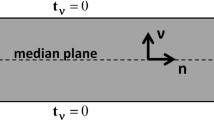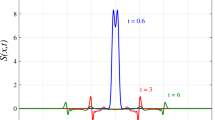Abstract
The classical method of characteristic surfaces and bicharacteristic rays is used to study acceleration and higher order discontinuities in nonlinear simple elastic materials. No special material symmetry is assumed, and the analysis requires neither material homogeneity nor uniform conditions ahead of the wave in general, although many detailed results do require the latter two conditions. This paper draws heavily on known results, but at the same time many other results, believed to be new, have been included. Analysis of the motion of the singular surface precedes a discussion of the amplitude equations. It is shown that the Jacobian determinant of a certain coordinate transformation, induced by the motion of the surface, plays a dominant role in the equations for transport of amplitude. New results on the kinematics of singular surfaces are given for homogeneous and uniform materials, including a formula for the evolution of surface curvature in anisotropic materials and a complete description of the role of the curvatures of the initial singular surface and of the characteristic slowness surface in producing expansion or focusing of the singular surface.
It is shown that the Jacobian determinant, mentioned above, produces a great simplification in the equations for transport of amplitude and bears significantly on the interpretation of solutions. Discontinuities of all higher orders are shown to be induced by a discontinuity of given order, and the implications of this result for transverse acceleration waves in isotropic materials are pointed out. Coupling of the modes of propagation for uniform multiplicity of slowness surfaces is described. Finally, it is shown that in directions of self intersection or conical intersection of slowness surfaces, the amplitude equations are not ordinary differential equations, but rather they are semilinear hyperbolic partial differential equations, and some of their properties are described. Hyperbolic transport equations have previously been shown to hold for some linear hyperbolic systems, but the kinematical description and reduction to a simple and readily interpretable form, as given here, are new.
It seems clear that the methods employed here could be extended to materials with constitutive behavior far more elaborate than simple elastic.
Similar content being viewed by others
References
Thomas, T.Y., Plastic Flow and Fracture in Solids. Mathematics in Science and Engineering, vol. 2. New York: Academic Press 1961, Chap. 2.
Coleman, B.D., & M.E. Gurtin, Waves in materials with memory II. On the growth and decay of one-dimensional acceleration waves. Arch. Rational Mech. Anal. 19, 239–265 (1965).
Chen, P.J., Thermodynamic influences on the propagation and the growth of acceleration waves in elastic materials. Arch. Rational Mech. Anal. 31, 228–254 (1968).
Bowen, R.M., Acceleration and higher order waves in a mixture of chemically reacting elastic materials. Arch. Rational Mech. Anal. 33, 169–180 (1969).
Bowen, R.M., & C.-C. Wang, Acceleration waves in inhomogeneous isotropic elastic bodies. Arch. Rational Mech. Anal. 38, 13–45 (1970); Corrigendum 40, 403 (1971).
Courant, R., & D. Hilbert, Methods of Mathematical Physics, II. New York: John Wiley (Interscience) 1962.
Varley, E., & E. Cumberbatch, Non-linear theory of wave-front propagation. J. Inst. Maths. Applics. 1, 101–112 (1965).
Varley, E., Acceleration fronts in viscoelastic materials. Arch. Rational Mech. Anal. 19, 215–225 (1965).
Nariboli, G.A., & B.L. Juneja, Second order waves in non-linear magneto-elasticity. Proc. Nat. Inst. Sci. India 33, 249–258 (1967).
Nariboli, G.A., Wave propagation in anisotropic elasticity. J. Math. Anal. Applic. 16, 108–122 (1966).
Juneja, B.L., & G.A. Nariboli, Growth of acceleration waves in an unstrained non-linear isotropic elastic medium. Int. J. Non-Linear Mech. 5, 513–524 (1970).
Truesdell, C., & R. Toupin, The Classical Field Theories. Flügge's Handbuch der Physik, III/1. Berlin-Göttingen-Heidelberg: Springer 1960.
Wang, C.-C., Material bodies with uniform symmetry. Int. J. Solids Struc. 6, 773–784 (1970).
Hayes, W.D., Kinematic wave theory. Proc. Roy. Soc. Lond. A, 320, 209–226 (1970).
Bowen, R.M., & C.-C. Wang, Acceleration waves in orthotropic elastic materials. Arch. Rational Mech. Anal. 47, 149–170 (1972).
Friedlander, F.G., Sound Pulses. Cambridge: University Press 1958.
Bailey, P.B., & P.J. Chen, On the local and global behavior of acceleration waves. Arch. Rational Mech. Anal. 41, 121–131 (1971); — On the local and global behavior of acceleration waves: Addendum, Asymptotic behavior. Arch. Rational Mech. Anal. 44, 212–216 (1972).
Ludwig, D., Conical refraction in crystal optics and hydromagnetics. Comm. Pure and Appl. Math. 14, 113–124 (1961).
Ludwig, D., & B. Granoff, Propagation of singularities along characteristics with nonuniform multiplicity. J. Math. Anal. Applic. 21, 556–574 (1968).
Chadwick, P., & R.W. Ogden, On the definition of elastic moduli. Arch. Rational Mech. Anal. 44, 41–53 (1971).
Chen, P., On the growth of longitudinal waves in anisotropic elastic materials. Arch. Rational Mech. Anal. 36, 381–389 (1970).
Kittel, C., Introduction to Solid State Physics, 4th ed. New York: Wiley 1971.
Musgrave, M.J.P., The propagation of elastic waves in crystals and other anisotropic media. Repts. Prog. Phys. 22, 74–96 (1959).
Green, W.A., The growth of plane discontinuities propagating into a homogeneously deformed elastic material. Arch. Rational Mech. Anal. 16, 79–88 (1964); — Corrections and additional results. Arch. Rational Mech. Anal. 19, 20–23 (1965).
Bowen, R.M., & P.J. Chen, Some comments on the behavior of acceleration waves of arbitrary shape. J. Math. Phys. 13, 948–950 (1972).
Suhubi, E.S., The growth of acceleration waves of arbitrary form in deformed hyperelastic materials. Int. J. Eng. Sci. 8, 699–710 (1970).
Author information
Authors and Affiliations
Additional information
Communicated by C. Truesdell
Rights and permissions
About this article
Cite this article
Wright, T.W. Acceleration waves in simple elastic materials. Arch. Rational Mech. Anal. 50, 237–277 (1973). https://doi.org/10.1007/BF00281508
Received:
Issue Date:
DOI: https://doi.org/10.1007/BF00281508




